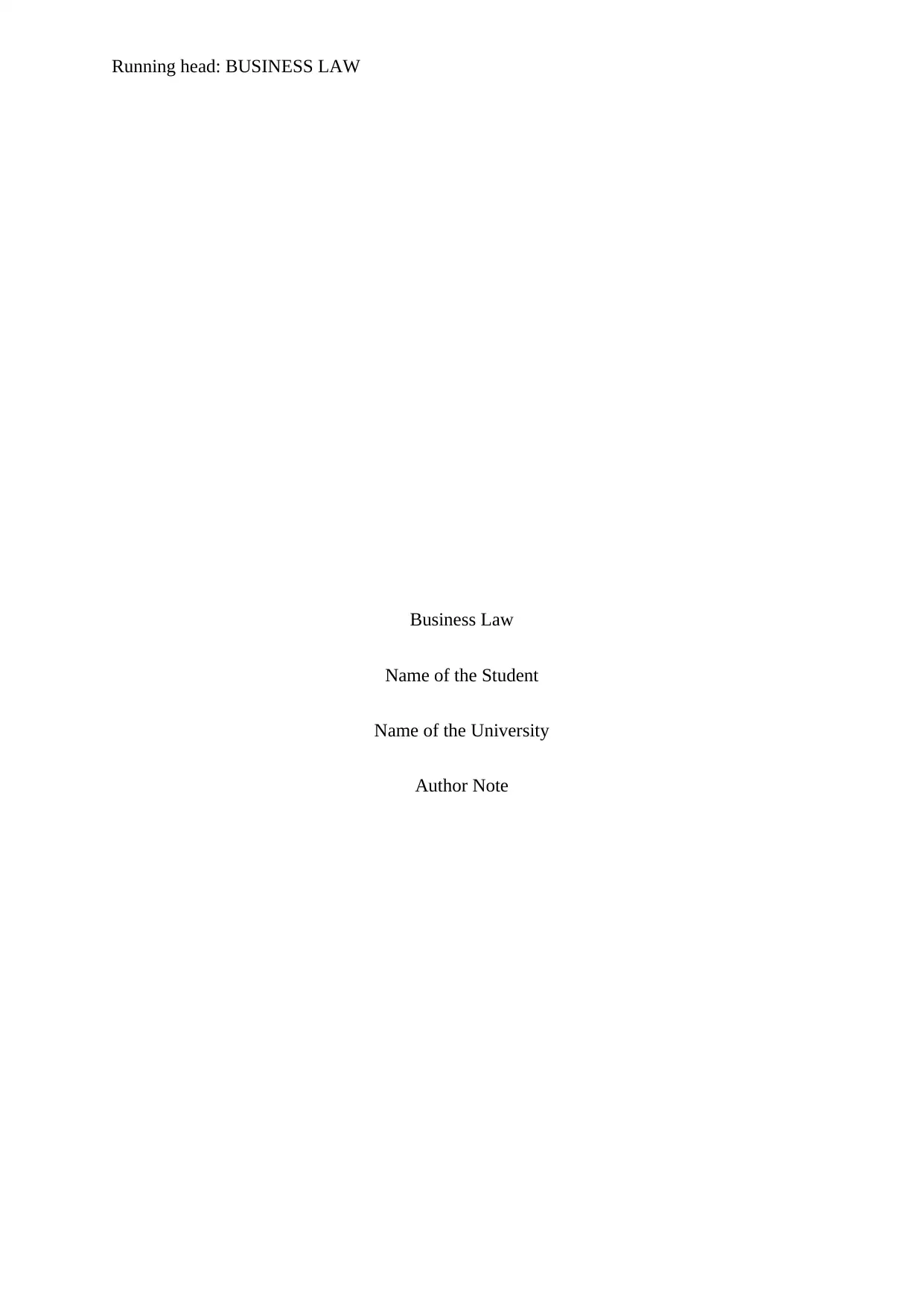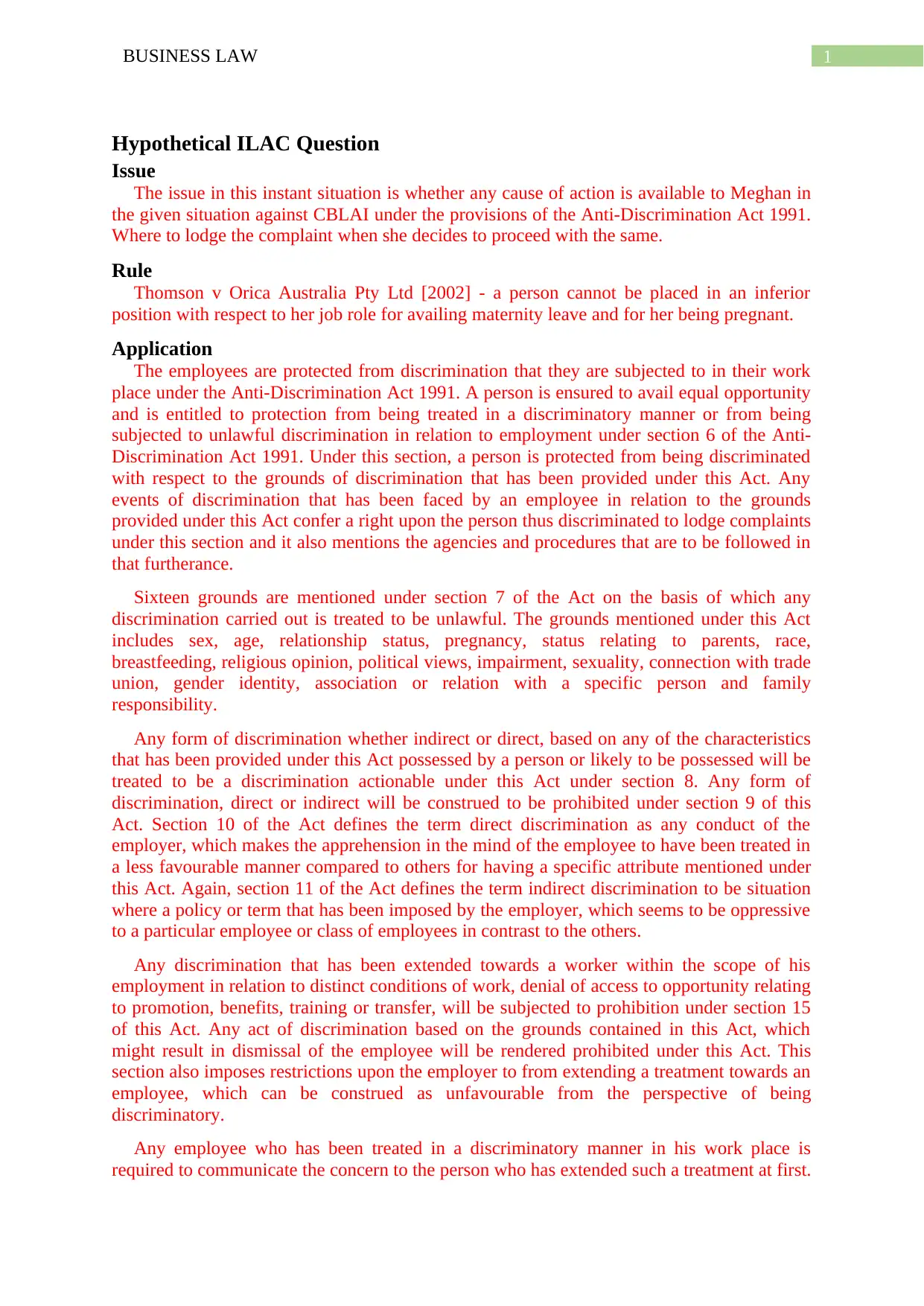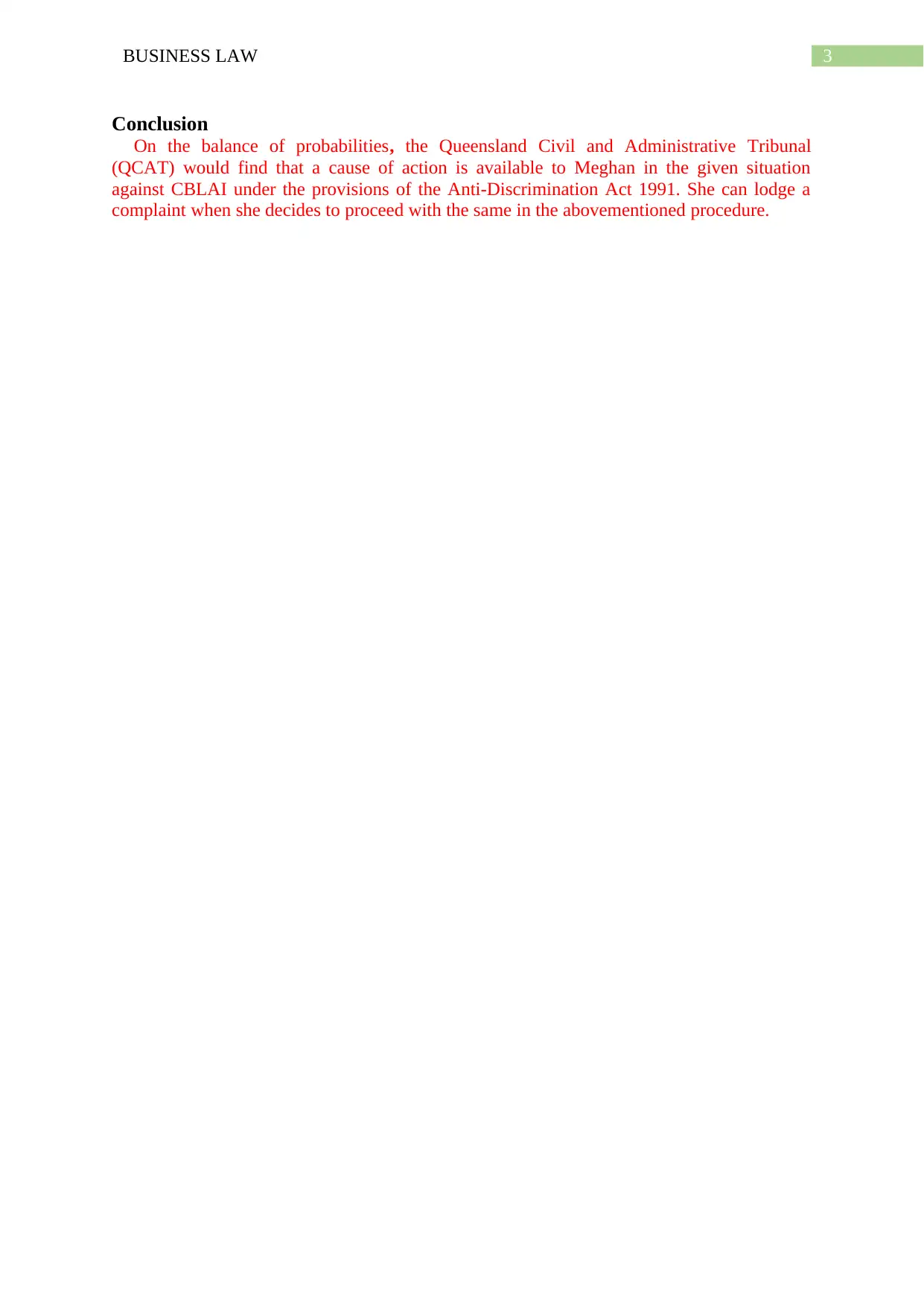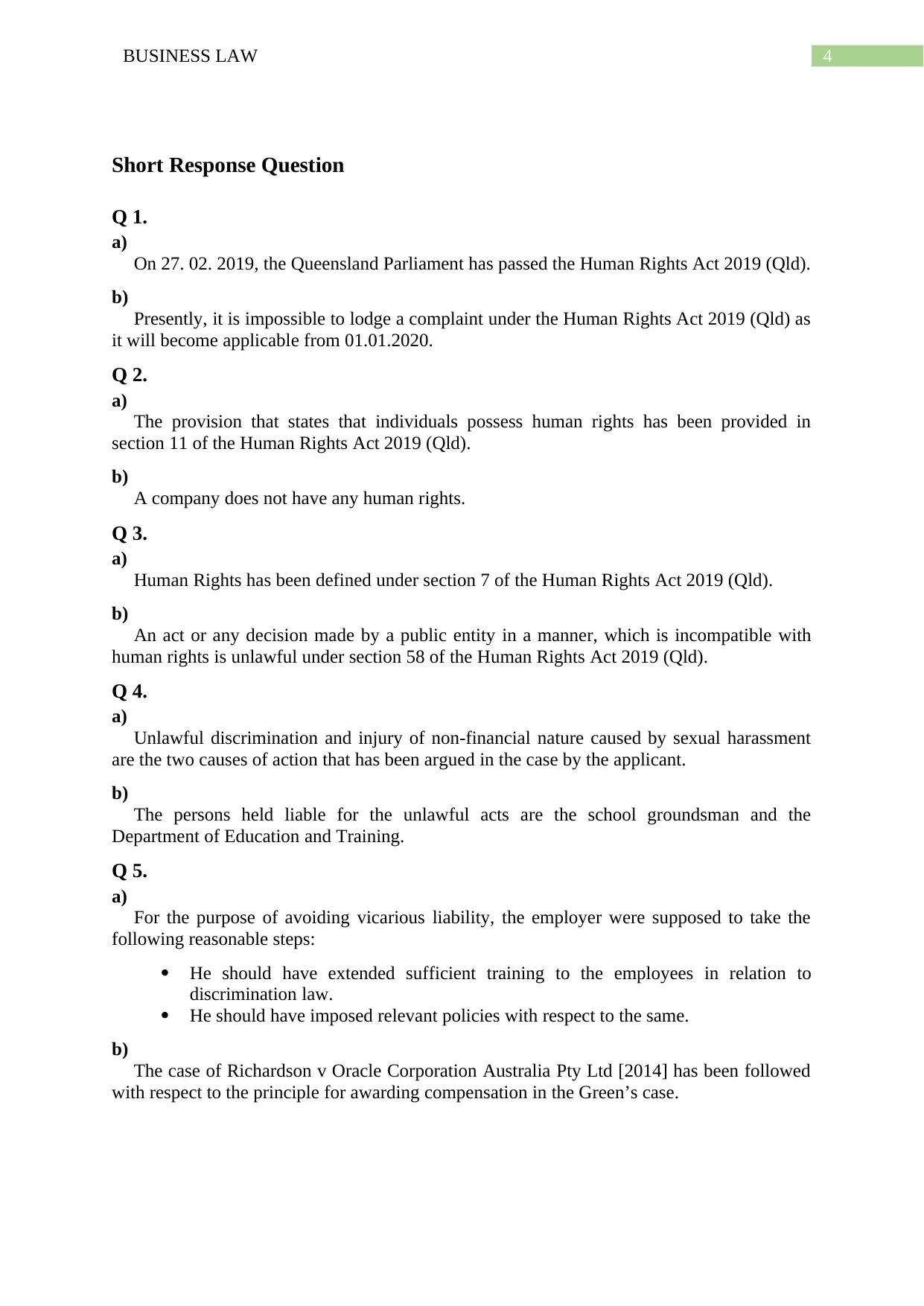Business Law Assignment: Anti-Discrimination Act & Case Study Analysis
VerifiedAdded on 2023/01/19
|5
|1755
|64
Homework Assignment
AI Summary
This assignment analyzes a business law case involving potential discrimination under the Anti-Discrimination Act 1991. The case study focuses on Meghan, a mortgage broker, and her experiences with her employer, CBLAI, concerning a promotion and subsequent demotion after informing them of her pregnancy and taking maternity leave. The assignment explores the legal principles of direct and indirect discrimination, referencing the case of Thomson v Orica Australia Pty Ltd [2002]. It examines the actions of the employer, HR, and senior executives, assessing whether these actions constitute unlawful discrimination under the Act. The assignment also addresses the procedures for lodging a complaint, including the roles of the Australian Human Rights Commission, the Anti-Discrimination Commission Queensland, and the Queensland Civil and Administrative Tribunal (QCAT) or Queensland Industrial Relations Commission (QIRC). Additionally, the assignment includes short answer questions covering the Human Rights Act 2019 (Qld), defining human rights, and the consequences of actions by public entities that are incompatible with human rights.

Running head: BUSINESS LAW
Business Law
Name of the Student
Name of the University
Author Note
Business Law
Name of the Student
Name of the University
Author Note
Paraphrase This Document
Need a fresh take? Get an instant paraphrase of this document with our AI Paraphraser

1BUSINESS LAW
Hypothetical ILAC Question
Issue
The issue in this instant situation is whether any cause of action is available to Meghan in
the given situation against CBLAI under the provisions of the Anti-Discrimination Act 1991.
Where to lodge the complaint when she decides to proceed with the same.
Rule
Thomson v Orica Australia Pty Ltd [2002] - a person cannot be placed in an inferior
position with respect to her job role for availing maternity leave and for her being pregnant.
Application
The employees are protected from discrimination that they are subjected to in their work
place under the Anti-Discrimination Act 1991. A person is ensured to avail equal opportunity
and is entitled to protection from being treated in a discriminatory manner or from being
subjected to unlawful discrimination in relation to employment under section 6 of the Anti-
Discrimination Act 1991. Under this section, a person is protected from being discriminated
with respect to the grounds of discrimination that has been provided under this Act. Any
events of discrimination that has been faced by an employee in relation to the grounds
provided under this Act confer a right upon the person thus discriminated to lodge complaints
under this section and it also mentions the agencies and procedures that are to be followed in
that furtherance.
Sixteen grounds are mentioned under section 7 of the Act on the basis of which any
discrimination carried out is treated to be unlawful. The grounds mentioned under this Act
includes sex, age, relationship status, pregnancy, status relating to parents, race,
breastfeeding, religious opinion, political views, impairment, sexuality, connection with trade
union, gender identity, association or relation with a specific person and family
responsibility.
Any form of discrimination whether indirect or direct, based on any of the characteristics
that has been provided under this Act possessed by a person or likely to be possessed will be
treated to be a discrimination actionable under this Act under section 8. Any form of
discrimination, direct or indirect will be construed to be prohibited under section 9 of this
Act. Section 10 of the Act defines the term direct discrimination as any conduct of the
employer, which makes the apprehension in the mind of the employee to have been treated in
a less favourable manner compared to others for having a specific attribute mentioned under
this Act. Again, section 11 of the Act defines the term indirect discrimination to be situation
where a policy or term that has been imposed by the employer, which seems to be oppressive
to a particular employee or class of employees in contrast to the others.
Any discrimination that has been extended towards a worker within the scope of his
employment in relation to distinct conditions of work, denial of access to opportunity relating
to promotion, benefits, training or transfer, will be subjected to prohibition under section 15
of this Act. Any act of discrimination based on the grounds contained in this Act, which
might result in dismissal of the employee will be rendered prohibited under this Act. This
section also imposes restrictions upon the employer to from extending a treatment towards an
employee, which can be construed as unfavourable from the perspective of being
discriminatory.
Any employee who has been treated in a discriminatory manner in his work place is
required to communicate the concern to the person who has extended such a treatment at first.
Hypothetical ILAC Question
Issue
The issue in this instant situation is whether any cause of action is available to Meghan in
the given situation against CBLAI under the provisions of the Anti-Discrimination Act 1991.
Where to lodge the complaint when she decides to proceed with the same.
Rule
Thomson v Orica Australia Pty Ltd [2002] - a person cannot be placed in an inferior
position with respect to her job role for availing maternity leave and for her being pregnant.
Application
The employees are protected from discrimination that they are subjected to in their work
place under the Anti-Discrimination Act 1991. A person is ensured to avail equal opportunity
and is entitled to protection from being treated in a discriminatory manner or from being
subjected to unlawful discrimination in relation to employment under section 6 of the Anti-
Discrimination Act 1991. Under this section, a person is protected from being discriminated
with respect to the grounds of discrimination that has been provided under this Act. Any
events of discrimination that has been faced by an employee in relation to the grounds
provided under this Act confer a right upon the person thus discriminated to lodge complaints
under this section and it also mentions the agencies and procedures that are to be followed in
that furtherance.
Sixteen grounds are mentioned under section 7 of the Act on the basis of which any
discrimination carried out is treated to be unlawful. The grounds mentioned under this Act
includes sex, age, relationship status, pregnancy, status relating to parents, race,
breastfeeding, religious opinion, political views, impairment, sexuality, connection with trade
union, gender identity, association or relation with a specific person and family
responsibility.
Any form of discrimination whether indirect or direct, based on any of the characteristics
that has been provided under this Act possessed by a person or likely to be possessed will be
treated to be a discrimination actionable under this Act under section 8. Any form of
discrimination, direct or indirect will be construed to be prohibited under section 9 of this
Act. Section 10 of the Act defines the term direct discrimination as any conduct of the
employer, which makes the apprehension in the mind of the employee to have been treated in
a less favourable manner compared to others for having a specific attribute mentioned under
this Act. Again, section 11 of the Act defines the term indirect discrimination to be situation
where a policy or term that has been imposed by the employer, which seems to be oppressive
to a particular employee or class of employees in contrast to the others.
Any discrimination that has been extended towards a worker within the scope of his
employment in relation to distinct conditions of work, denial of access to opportunity relating
to promotion, benefits, training or transfer, will be subjected to prohibition under section 15
of this Act. Any act of discrimination based on the grounds contained in this Act, which
might result in dismissal of the employee will be rendered prohibited under this Act. This
section also imposes restrictions upon the employer to from extending a treatment towards an
employee, which can be construed as unfavourable from the perspective of being
discriminatory.
Any employee who has been treated in a discriminatory manner in his work place is
required to communicate the concern to the person who has extended such a treatment at first.

2BUSINESS LAW
Secondly, when the communication with the first person did not made any help, he may
communicate the same with the higher authority of his employer. As a next resort he may
make a complaint in the Australian Human Rights Commission or the Anti-Discrimination
Commission Queensland. These commissions will strive to settle the dispute by way of
conciliation. The failure of the conciliation in solving the dispute will leave the employee
with the last resort to approach the Queensland Civil and Administrative Tribunal (QCAT) or
the Queensland Industrial Relations Commission (QIRC) to avail a formal hearing.
In the case of Thomson v Orica Australia Pty Ltd [2002], it has been contended by the
court that a person cannot be placed in an inferior position with respect to her job role for
availing maternity leave and for her being pregnant. This can be construed to be a less
favourable treatment in relation to the anti-discriminatory laws.
In the instant scenario, Meghan is highly trained mortgage broker at ‘Corrupt Banking
Loans Australia Incorporated’ (CBLAI). She has been employed with the CBLAI for more
than two years. She has an experience of ten years in that particular industry. Ten months
prior to the present, she made an application for the purpose of a promotion of the role of a
Senior Broker. During the interview several questions relating to her future strategy with the
company has led to the disclosure of her being pregnant. On being aware of her pregnancy,
the HR Kate instantly asked her to drop the discussion of her being pregnant as the same
cannot be construed to be relevant to the job role she has been interviewing for. Moreover,
the HR suggested her to discuss about her qualification and experiences and contended that in
her opinion those are more important to be discussed for the purpose of the instant interview.
On the other hand, Meghan has heard one of the senior executives namely Charles
commenting on the situation and laughing at her being pregnant. This made Meghan consider
the confession and the same made her devastated when she has been made aware of her not
getting the job. She has also been informed that the position she has interviewed for has been
assigned to some person who has an identical qualification to her. However, it has been
contended by the employer that the employment has been given to him for his better
performance during the interview. This act of the employer in not giving the job to Meghan
can be construed to be a form of discrimination under section 15. It is evident from the
turnoff events that promotion has been refused to Meghan owing to the knowledge of the
employer of her being pregnant.
Moreover, Meghan has went on a maternity leave shortly after this event. She has been
demoted to an inferior job role after the completion of her maternity leave when she returned.
The new job role that has been provided to her was earning her the same remuneration that
she has been provided previously. However, she has been disappointed with the new job role
as it seemed to be inferior than her previous position. She has also initiated a complaint to the
HR mentioning the same. The response that has been furnished by the HR in relation to the
same was that the demotion was a decision taken for the best interest of her motherhood and
the interest of the company. Again, a subsequent application of Meghan for a part-time role
has been refused. This makes the motive of discrimination of the employer with respect to
Meghan in owing to her pregnancy evident. This can be treated to be an act of discrimination
applying the facts of the case of Thomson v Orica Australia Pty Ltd [2002].
In this case, Meghan has already tried to communicate the concern with the employer.
Now she can lodge a complaint before the Australian Human Rights Commission or the Anti-
Discrimination Commission Queensland or Australian Human Rights Commission and avail
a conciliation. In case of a failure in the conciliation she may proceed for a formal hearing in
front of the Queensland Civil and Administrative Tribunal (QCAT) or the Queensland
Industrial Relations Commission (QIRC).
Secondly, when the communication with the first person did not made any help, he may
communicate the same with the higher authority of his employer. As a next resort he may
make a complaint in the Australian Human Rights Commission or the Anti-Discrimination
Commission Queensland. These commissions will strive to settle the dispute by way of
conciliation. The failure of the conciliation in solving the dispute will leave the employee
with the last resort to approach the Queensland Civil and Administrative Tribunal (QCAT) or
the Queensland Industrial Relations Commission (QIRC) to avail a formal hearing.
In the case of Thomson v Orica Australia Pty Ltd [2002], it has been contended by the
court that a person cannot be placed in an inferior position with respect to her job role for
availing maternity leave and for her being pregnant. This can be construed to be a less
favourable treatment in relation to the anti-discriminatory laws.
In the instant scenario, Meghan is highly trained mortgage broker at ‘Corrupt Banking
Loans Australia Incorporated’ (CBLAI). She has been employed with the CBLAI for more
than two years. She has an experience of ten years in that particular industry. Ten months
prior to the present, she made an application for the purpose of a promotion of the role of a
Senior Broker. During the interview several questions relating to her future strategy with the
company has led to the disclosure of her being pregnant. On being aware of her pregnancy,
the HR Kate instantly asked her to drop the discussion of her being pregnant as the same
cannot be construed to be relevant to the job role she has been interviewing for. Moreover,
the HR suggested her to discuss about her qualification and experiences and contended that in
her opinion those are more important to be discussed for the purpose of the instant interview.
On the other hand, Meghan has heard one of the senior executives namely Charles
commenting on the situation and laughing at her being pregnant. This made Meghan consider
the confession and the same made her devastated when she has been made aware of her not
getting the job. She has also been informed that the position she has interviewed for has been
assigned to some person who has an identical qualification to her. However, it has been
contended by the employer that the employment has been given to him for his better
performance during the interview. This act of the employer in not giving the job to Meghan
can be construed to be a form of discrimination under section 15. It is evident from the
turnoff events that promotion has been refused to Meghan owing to the knowledge of the
employer of her being pregnant.
Moreover, Meghan has went on a maternity leave shortly after this event. She has been
demoted to an inferior job role after the completion of her maternity leave when she returned.
The new job role that has been provided to her was earning her the same remuneration that
she has been provided previously. However, she has been disappointed with the new job role
as it seemed to be inferior than her previous position. She has also initiated a complaint to the
HR mentioning the same. The response that has been furnished by the HR in relation to the
same was that the demotion was a decision taken for the best interest of her motherhood and
the interest of the company. Again, a subsequent application of Meghan for a part-time role
has been refused. This makes the motive of discrimination of the employer with respect to
Meghan in owing to her pregnancy evident. This can be treated to be an act of discrimination
applying the facts of the case of Thomson v Orica Australia Pty Ltd [2002].
In this case, Meghan has already tried to communicate the concern with the employer.
Now she can lodge a complaint before the Australian Human Rights Commission or the Anti-
Discrimination Commission Queensland or Australian Human Rights Commission and avail
a conciliation. In case of a failure in the conciliation she may proceed for a formal hearing in
front of the Queensland Civil and Administrative Tribunal (QCAT) or the Queensland
Industrial Relations Commission (QIRC).
⊘ This is a preview!⊘
Do you want full access?
Subscribe today to unlock all pages.

Trusted by 1+ million students worldwide

3BUSINESS LAW
Conclusion
On the balance of probabilities, the Queensland Civil and Administrative Tribunal
(QCAT) would find that a cause of action is available to Meghan in the given situation
against CBLAI under the provisions of the Anti-Discrimination Act 1991. She can lodge a
complaint when she decides to proceed with the same in the abovementioned procedure.
Conclusion
On the balance of probabilities, the Queensland Civil and Administrative Tribunal
(QCAT) would find that a cause of action is available to Meghan in the given situation
against CBLAI under the provisions of the Anti-Discrimination Act 1991. She can lodge a
complaint when she decides to proceed with the same in the abovementioned procedure.
Paraphrase This Document
Need a fresh take? Get an instant paraphrase of this document with our AI Paraphraser

4BUSINESS LAW
Short Response Question
Q 1.
a)
On 27. 02. 2019, the Queensland Parliament has passed the Human Rights Act 2019 (Qld).
b)
Presently, it is impossible to lodge a complaint under the Human Rights Act 2019 (Qld) as
it will become applicable from 01.01.2020.
Q 2.
a)
The provision that states that individuals possess human rights has been provided in
section 11 of the Human Rights Act 2019 (Qld).
b)
A company does not have any human rights.
Q 3.
a)
Human Rights has been defined under section 7 of the Human Rights Act 2019 (Qld).
b)
An act or any decision made by a public entity in a manner, which is incompatible with
human rights is unlawful under section 58 of the Human Rights Act 2019 (Qld).
Q 4.
a)
Unlawful discrimination and injury of non-financial nature caused by sexual harassment
are the two causes of action that has been argued in the case by the applicant.
b)
The persons held liable for the unlawful acts are the school groundsman and the
Department of Education and Training.
Q 5.
a)
For the purpose of avoiding vicarious liability, the employer were supposed to take the
following reasonable steps:
He should have extended sufficient training to the employees in relation to
discrimination law.
He should have imposed relevant policies with respect to the same.
b)
The case of Richardson v Oracle Corporation Australia Pty Ltd [2014] has been followed
with respect to the principle for awarding compensation in the Green’s case.
Short Response Question
Q 1.
a)
On 27. 02. 2019, the Queensland Parliament has passed the Human Rights Act 2019 (Qld).
b)
Presently, it is impossible to lodge a complaint under the Human Rights Act 2019 (Qld) as
it will become applicable from 01.01.2020.
Q 2.
a)
The provision that states that individuals possess human rights has been provided in
section 11 of the Human Rights Act 2019 (Qld).
b)
A company does not have any human rights.
Q 3.
a)
Human Rights has been defined under section 7 of the Human Rights Act 2019 (Qld).
b)
An act or any decision made by a public entity in a manner, which is incompatible with
human rights is unlawful under section 58 of the Human Rights Act 2019 (Qld).
Q 4.
a)
Unlawful discrimination and injury of non-financial nature caused by sexual harassment
are the two causes of action that has been argued in the case by the applicant.
b)
The persons held liable for the unlawful acts are the school groundsman and the
Department of Education and Training.
Q 5.
a)
For the purpose of avoiding vicarious liability, the employer were supposed to take the
following reasonable steps:
He should have extended sufficient training to the employees in relation to
discrimination law.
He should have imposed relevant policies with respect to the same.
b)
The case of Richardson v Oracle Corporation Australia Pty Ltd [2014] has been followed
with respect to the principle for awarding compensation in the Green’s case.
1 out of 5
Related Documents
Your All-in-One AI-Powered Toolkit for Academic Success.
+13062052269
info@desklib.com
Available 24*7 on WhatsApp / Email
![[object Object]](/_next/static/media/star-bottom.7253800d.svg)
Unlock your academic potential
Copyright © 2020–2025 A2Z Services. All Rights Reserved. Developed and managed by ZUCOL.





![Lyons v Queensland [2016] HCA 38: Case Analysis and Precedent](/_next/image/?url=https%3A%2F%2Fdesklib.com%2Fmedia%2Fimages%2Fem%2F5a6d28e919464e63be0e7ff33ce726fc.jpg&w=256&q=75)